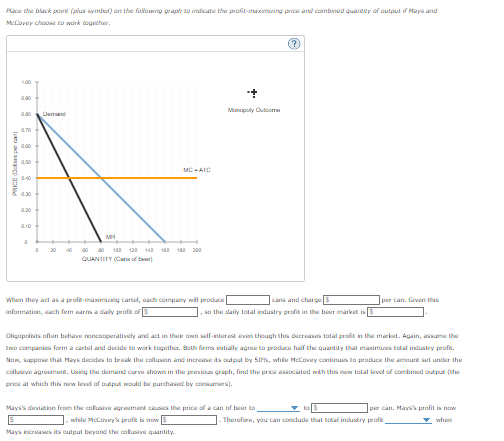6. Deviating from the collusive outcome Mays and McCovey are beer-brewing companies that operate in a duopoly (two-firm oligopoly). The daily marginal cost (MC) of producing a can of beer is constant and equals $0.40 per can. Assume that neither firm had any startup costs, so marginal cost equals average total cost (ATC) for each firm. Suppose that Mays and McCovey form a cartel, and the firms divide the output evenly. (Note: This is only for convenience; nothing in this model requires that the two companies must equally share the output.) Place the black point (plus symbol) on the following graph to indicate the profit-maximizing price and combined quantity of output if Mays and McCovey choose to work together.
6. Deviating from the collusive outcome Mays and McCovey are beer-brewing companies that operate in a duopoly (two-firm oligopoly). The daily marginal cost (MC) of producing a can of beer is constant and equals $0.40 per can. Assume that neither firm had any startup costs, so marginal cost equals average total cost (ATC) for each firm. Suppose that Mays and McCovey form a cartel, and the firms divide the output evenly. (Note: This is only for convenience; nothing in this model requires that the two companies must equally share the output.) Place the black point (plus symbol) on the following graph to indicate the profit-maximizing price and combined quantity of output if Mays and McCovey choose to work together.
Principles of Economics 2e
2nd Edition
ISBN:9781947172364
Author:Steven A. Greenlaw; David Shapiro
Publisher:Steven A. Greenlaw; David Shapiro
Chapter10: Monopolistic Competition And Oligopoly
Section: Chapter Questions
Problem 3SCQ: Consider the curve in the figure below, which shows the market demand. marginal cost, and marginal...
Related questions
Question

Transcribed Image Text:6. Deviating from the collusive outcome
Mays and McCovey are beer-brewing companies that operate in a duopoly (two-firm oligopoly). The daily marginal cost (MC) of producing a can of
beer is constant and equals $0.40 per can. Assume that neither firm had any startup costs, so marginal cost equals average total cost (ATC) for each
firm.
Suppose that Mays and McCovey form a cartel, and the firms divide the output evenly. (Note: This is only for convenience; nothing in this model
requires that the two companies must equally share the output.)
Place the black point (plus symbol) on the following graph to indicate the profit-maximizing price and combined quantity of output if Mays and
McCovey choose to work together.

Transcribed Image Text:Place the black point (plus symbol) on the following graph to indicate the profit-maximizing price and combined quantity of output if Mays and
McCovey choose to work together.
and g
1.00
090
0.70
0.50
0.40
0.30
0.20
0.10
0
Derrand
40
MC-AIC
MH
00 100 120 140 100 100 200
QUANTITY (Cao)
+
When they act as a profit-maximizing cartel, each company will produce
information, each firm earns a daily profit of 5
Monopoly Outcom
cans and charge
so the daily total industry profit in the bear market is 5
(?)
Mays's deviation from the collusive agreement causes the price of a can of beer to
while McCovey's profit is now
Mays increases its output beyond the collusive quantity.
per can. Given this
Oligopolists often behave noncooperatively and act in their own self-interest even though this decreases total profit in the market. Again, assume the
two companies form a cartel and decide to work together. Both firms initially agree to produce half the quantity that maximizes total industry profit.
Now, suppose that Mays decides to break the collusion and increase its output by 50%, while McCovey continues to produce the amount set under the
collusive agreement. Using the demand curve shown in the previous graph, find the price associated with this new total level of combined output (the
price at which this new level of output would be purchased by consumers).
per can. Mays's profit is now
when
Therefore, you can conclude that total industry profit
Expert Solution
This question has been solved!
Explore an expertly crafted, step-by-step solution for a thorough understanding of key concepts.
This is a popular solution!
Trending now
This is a popular solution!
Step by step
Solved in 2 steps with 2 images

Knowledge Booster
Learn more about
Need a deep-dive on the concept behind this application? Look no further. Learn more about this topic, economics and related others by exploring similar questions and additional content below.Recommended textbooks for you

Principles of Economics 2e
Economics
ISBN:
9781947172364
Author:
Steven A. Greenlaw; David Shapiro
Publisher:
OpenStax

Managerial Economics: Applications, Strategies an…
Economics
ISBN:
9781305506381
Author:
James R. McGuigan, R. Charles Moyer, Frederick H.deB. Harris
Publisher:
Cengage Learning

Exploring Economics
Economics
ISBN:
9781544336329
Author:
Robert L. Sexton
Publisher:
SAGE Publications, Inc

Principles of Economics 2e
Economics
ISBN:
9781947172364
Author:
Steven A. Greenlaw; David Shapiro
Publisher:
OpenStax

Managerial Economics: Applications, Strategies an…
Economics
ISBN:
9781305506381
Author:
James R. McGuigan, R. Charles Moyer, Frederick H.deB. Harris
Publisher:
Cengage Learning

Exploring Economics
Economics
ISBN:
9781544336329
Author:
Robert L. Sexton
Publisher:
SAGE Publications, Inc


Principles of Microeconomics (MindTap Course List)
Economics
ISBN:
9781305971493
Author:
N. Gregory Mankiw
Publisher:
Cengage Learning

Principles of Microeconomics
Economics
ISBN:
9781305156050
Author:
N. Gregory Mankiw
Publisher:
Cengage Learning